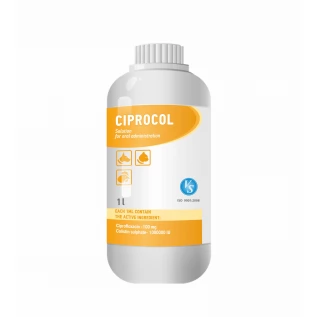DESCRIPTION
Liquid from light-yellow to dark-yellow color, slight sediment may appear.
COMPOSITION
PHARMACOLOGICAL PROPERTIES
Ciprocol – is a combined preparation that contains two antibiotics. As a result of the synergy of the active ingredients, the effectiveness of Ciprocol is significantly higher than its individual components.
Ciprofloxacin – is an antibiotic from fluoroquinolones group. It’s active against gram-negative and gram-positive bacteria, especially against Е.coli, Salmonella spp., Shigella spp., Enterobacter spp., Klebsiella spp., Proteus spp., Serratia spp., Camphylobacter spp., Pseudomonas aeruginosa, Yersinia spp., Vibrio spp., Aeromonas spp., Haemophilus spp., to the preparation are also sensitive: Brucella spp., Staphylococcus spp. (including penicillinase-producing and methicillin-resistant strains), Mycoplasma spp., Mycobacterium spp.. The mode of action of ciprofloxacin is the inhibition of bacterial DNA – gyrase (topoisomerase II), thus stopping the process of replication of DNA.
Colistin is an antibiotic of polimixin group that synthesizes by aerobic spore-forming rod Bacillus polymyxa. It has bactericidal effects on gram-negative (such as E. coli, Salmonella spp., Pseudomonas spp.), binding to phospholipids of the cytoplasmic membrane, increasing its permeability for internal and external cellular components, which leads to destruction of cellular barrier and lysis of bacterial cell.
INDICATIONS
Treatment of poultry (chickens, broilers, turkeys), doves and dogs, that suffers from colibacteriosis, salmonellosis, streptococcus, pasteurellosis, or from chronic respiratory diseases (CRD), diseases of gastrointestinal tract, mixed and secondary infections during viral diseases, caused by microorganisms, susceptible to ciprofloxacin and colistin.
DOSAGE
Orally for 3-5 days at the following doses:
Poultry (chickens, broilers, turkeys) and doves: 0.5-1 ml per 1 liter of drinking water.
Dogs: 0.07-0.1 ml per 10 kg of body weight.
CONTRAINDICATIONS
PRECAUTIONS
If used simultaneously with aminoglycosides, cephalosporins of third generation and broad-spectrum penicillins, a synergism may occur against certain bacteria (especially Pseudomonas aeruginosa and other Enterobacteriaceae).
